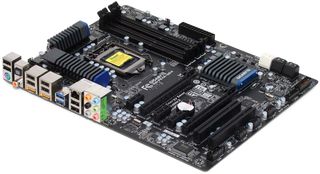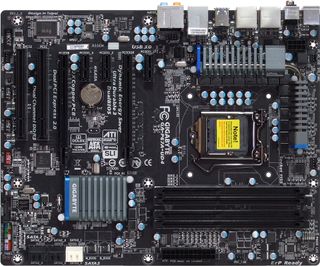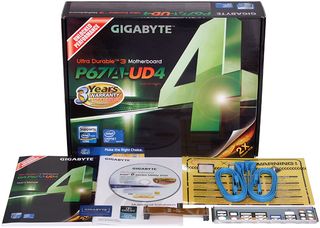P67 Motherboard Roundup: Nine $150-200 Boards
Improved per-clock performance and higher achievable frequencies are sure to put Intel’s latest K-Series CPUs on top of many builders’ whish lists, but they’ll still need a new socket to put it in. We test nine enthusiast-oriented LGA-1155 motherboards.
Gigabyte P67A-UD4
Gigabyte surprised us by providing a motherboard produced in Taiwan, rather than mainland China. We remember the days when this implied higher quality, so that label stuck in our head throughout testing. It’s also the only motherboard to feature a matte black (rather than glossy) finish on the PCB.

Another surprise was the lack of IEEE-1394 FireWire. This editor hasn’t even seen a FireWire device since 2008, so the savings of precious motherboard real estate would be a good enough excuse to get rid of it even before we consider its added cost. Yet, Gigabyte has always loved FireWire, and this is the same company that made us live with rear-panel parallel ports until mid-2007. The sudden swing towards modernization is somewhat refreshing from a company that’s better known for longevity.

Gigabyte is the third company to add the front-panel USB 3.0 connector first introduced by ASRock and reportedly developed by Intel. This is a good sign for case companies that have been waiting for a standard to emerge. Gigabyte is also one of the few companies to offer RAID support on its eSATA ports.
Two PCIe x16 slots use automatic lane switches to change from single-x16 to dual-x8 mode whenever a card is added to the lower slot. That second slot is also three spaces from the first for improved cooling to the upper card. The “missing” third slot offered by some competitors would have been limited to x4 transfers, so Gigabyte left if out in favor of legacy PCI (bottom) and PCIe x1 (top).
The P67A-UD4’s 14-phase voltage regulator screams “made for overclocking” louder than the custom colors and heat sinks ever could, though anyone who likes to show off with both looks and performance will enjoy all of these updates.
One thing that hasn’t been updated is the front-panel audio connector, which follows Gigabyte’s tradition by being placed forward of the I/O panel’s jacks. This allows front-panel cables to reach from nearly any direction, even if the cable was made too short for competing boards. The design also makes hiding the cable much more difficult, but many of the builders on this site enjoy the design’s improved functionality in spite of quibbles over form.

Gigabyte’s final surprise is the elimination of its supersized cable kit. An SLI bridge and four SATA cables are probably enough for most enthusiasts, but those who prefer CrossFire must make sure they pick a card that includes its own bridge connector. Cost cutting here potentially allows features like RAID support for the eSATA controller to exist within the P67A-UD4’s intended price class, but the lack of any front-panel USB 3.0 bay adapter will be sorely missed by builders who cannot wait for cases to adopt the new internal interface already presented on this board.
Stay on the Cutting Edge
Join the experts who read Tom's Hardware for the inside track on enthusiast PC tech news — and have for over 25 years. We'll send breaking news and in-depth reviews of CPUs, GPUs, AI, maker hardware and more straight to your inbox.
-
reprotected I thought that the ECS looked pretty sick, and it did perform alright. But unfortunately, it wasn't the best.Reply -
rantsky You guys rock! Thanks for the review!Reply
I'm just missing benchmarks like SATA/USB speeds etc. Please Tom's get those numbers for us! -
rmse17 Thanks for the prompt review of the boards! I would like to see any differences in quality of audio and networking components. For example, what chipsets are used for Audio in each board, how that affects sound quality. Same thing for network, which chipset is used for networking, and bandwidth benchmarks. If you guys make part 2 to the review, it would be nice to see those features, as I think that would be one more way these boards would differentiate themselves.Reply -
VVV850 Would have been good to know the bios version for the tested motherboards. Sorry if I double posted.Reply -
flabbergasted I'm going for the ASrock because I can use my socket 775 aftermarket cooler with it.Reply -
stasdm Do not see any board worth spending money on.Reply
1. SLI "support". Do not understand why end-user has to pay for mythical SLI "sertification" (all latest Intel chips support SLI by definition) and a SLI bridge coming with the board (at least 75% of end users would never need one). The bridge should come with NVIDIA cards (same as with AMD ones). Also, in x8/x8 PCIe configuration nearly all NVIDIA cards (exept for low-end ones) will loose at least 12% productivity - with top cards that is about $100 spent for nothing (AMD cards would not see that difference). So, If those cards are coming as SLI-"sertified" they have to be, in the worst case, equipped by NVIDIA NF200 chip (though, I would not recommend to by cards with this PCIe v.1.1 bridge). As even NVIDIA GF110 cards really need less than 1GB/s bandwidth (all other NVIDIA and AMD - less than 0.8GB/s)and secondary cards in SLI/CrossFire use no more than 1/4 of that, a normal PCIe v.2.0 switch (costing less than thrown away with x8/x8 SLI money) will nicely support three "Graphics only" x16 slots, fully-functional x8 slot and will provide bandwidth enough to support one PCIe v.2.0 x4 (or 4 x x1) slot(s)/device(s).
2. Do not understand the author euphoria of mass use of Marvell "SATA 6G" chips. The PCIe x1 chip might not be "SATA 6G" by definision, as it woud newer be able to provide more than 470GB/s (which is far from the standard 600GB/s) - so, I'd recommend to denote tham as 3G+ or 6G-. As it is shown in the upper section, there is enough bandwidth for real 6G solution (PCIe x8 LSISAS 2008 or x4 LSISAS 2004). Yes, will be a bit more expensive, but do not see the reason to have a palliative solutions on $200+ mobos.
-
I was hoping that the new Asus Sabertooth P67 would be included. Its new design really is leaving people wondering if the change is as good as they claim.Reply
Most Popular


